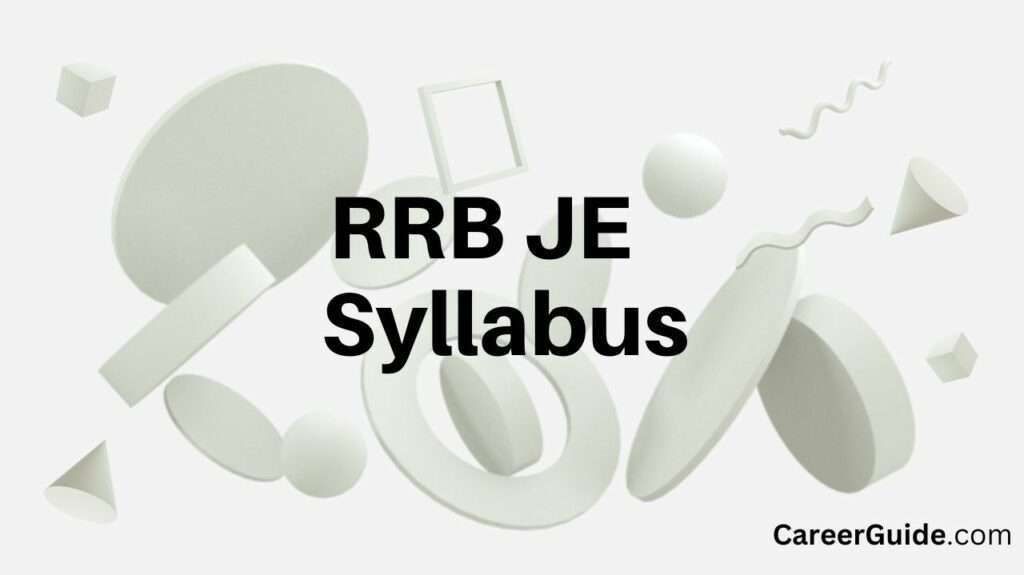RRB JE Syllabus
-
Nov 10
- Share post
RRB JE Syllabus: The Railway Recruitment Board (RRB) Junior Engineer (JE) exam is a highly competitive examination that assesses candidates’ knowledge and skills in various domains. The syllabus for the RRB JE exam is comprehensive, covering a range of subjects to ensure that candidates are well-prepared for the challenges of the job.
The examination process consists of two stages: the First Stage Computer Based Test (CBT-1) and the Second Stage Computer Based Test (CBT-2), followed by document verification and a medical examination.

Introduction to RRB JE
The Railroad Enlistment Board (RRB) Junior Design (JE) exam could be a profoundly competitive examination that surveys candidates’ information and abilities in different spaces. The syllabus for the RRB JE exam is comprehensive, covering a run of subjects to guarantee that candidates are well-prepared for the challenges of the work. The examination prepare comprises of two stages: the Primary Arrange Computer Based Test (CBT-1) and the Moment Organize Computer Based Test (CBT-2), taken after by archive confirmation and a therapeutic examination.
RRB JE Syllabus
First Stage Computer Based Test (CBT-1):
a. Mathematics:
- Number systems.
- BODMAS.
- Decimals and Fractions.
- LCM and HCF.
- Ratio and Proportion.
- Percentages.
- Mensuration.
- Time and Work.
- Time and Distance.
- Simple and Compound Interest.
- Profit and Loss.
- Algebra.
- Geometry and Trigonometry.
- Elementary Statistics.
- Square Root.
- Age Calculations.
- Calendar & Clock.
- Pipes & Cistern.
b. General Intelligence and Reasoning:
- Analogies.
- Alphabetical and Number Series.
- Coding and Decoding.
- Mathematical operations.
- Relationships.
- Syllogism.
- Jumbling.
- Venn Diagram.
- Data Interpretation and Sufficiency.
- Conclusions and Decision Making.
- Similarities and Differences.
- Analytical reasoning.
c. General Awareness:
- Current Affairs.
- Indian History.
- Geography.
- Economics.
- General Polity and Constitution of India.
- Environmental issues.
- Science & Technology.
- Sports.
Second Stage Computer Based Test (CBT-2)
a. General Awareness:
- Knowledge of current affairs.
- Indian geography.
- Culture and history of India.
- Indian Polity and Constitution.
- Environmental issues concerning India and the World.
- Sports.
- General scientific and technological developments, etc.
b. Physics and Chemistry:
- Up to 10th standard CBSE syllabus.
c. Basics of Computers and Applications:
- Architecture of Computers.
- Input and Output devices.
- Storage devices.
- Networking.
- Operating System like Windows, Unix, Linux.
- MS Office (Word, Excel, PowerPoint).
- Internet and Email.
- Websites & Web Browsers.
- Computer Virus.
d. Basics of Environment and Pollution Control:
- Basics of Environment.
- Adverse effect of environmental pollution.
- Air, water, and noise pollution.
- Waste Management.
Document Verification and Medical Examination
- Candidates who qualify CBT-2 are called for document verification.
- A medical examination is conducted to ensure that the candidates are medically fit for the job.
Important Tips for Preparation
Understand the Exam Pattern:
- Know the structure of both CBT-1 and CBT-2.
- Practice with mock tests to get a feel for the exam.
Subject-wise Focus:
- Allocate time based on the weightage of each subject.
- Strengthen your weak areas.
Current Affairs:
- Stay updated with current affairs related to national and international events.
Time Management:
- Practice time management during the exam.
- Solve previous years’ question papers within the stipulated time.
Regular Revision:
- Regularly revise important concepts.
- Make concise notes for quick revision.
Health and Fitness:
- Maintain a healthy lifestyle during preparation.
- Ensure adequate sleep and breaks.
Stay Informed:
- Keep an eye on the official RRB notifications for any updates.
Frequently Asked Questions (FAQs)
A1: The RRB JE syllabus includes subjects such as Mathematics, General Intelligence and Reasoning, General Awareness, Physics and Chemistry, Basics of Computers and Applications, and Basics of Environment and Pollution Control.
A2: The RRB JE exam consists of two stages: CBT-1 (First Stage Computer Based Test) and CBT-2 (Second Stage Computer Based Test). CBT-1 focuses on basic subjects, while CBT-2 is more specialized and includes additional topics.
A3: The Mathematics section covers topics such as Number Systems, BODMAS, Decimals and Fractions, LCM and HCF, Ratio and Proportion, Percentages, Mensuration, Time and Work, Algebra, Geometry and Trigonometry, among others.
A4: The General Intelligence and Reasoning section assesses logical and analytical abilities through questions on Analogies, Series, Coding and Decoding, Relationships, Syllogism, Data Interpretation, Decision Making, and Analytical Reasoning.
- X
- Telegram
- Tumblr
- VKontakte
- Copy link
- Share via...